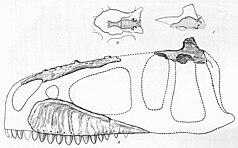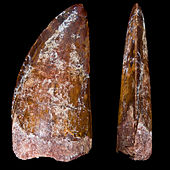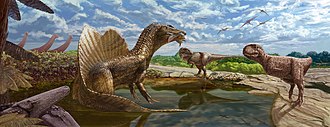Carcharodontosaurus
Carcharodontosaurus is one of the largest theropod dinosaurs known, reaching 10–12.5 m (33–41 ft) in length and approximately 4–7 metric tons (4.4–7.7 short tons) in body mass. It had a large, lightly built skull with a triangular rostrum. Its jaws were lined with sharp, recurved, serrated teeth that bear striking resemblances to those of the great white shark (genus Carcharodon), the inspiration for the name. Though giant, its cranium was made lighter by greatly expanded fossae and fenestra, but also making it more fragile than tyrannosaurids'. Studies of the bite force and tooth anatomy of carcharodontosaurids have found them to have relatively low bite force compared to other (large) theropods. The forelimbs were tiny whereas the hindlimbs were robust and muscular. Like most other theropods, it had an elongated tail for balance.
Many gigantic theropods are known from North Africa during this period, including both species of Carcharodontosaurus as well as the spinosaurid Spinosaurus, the possible ceratosaur Deltadromeus, the large, dubious theropod Bahariasaurus, and an unnamed large abelisaurid. North Africa at the time was blanketed in mangrove forests and wetlands, creating a hotspot of fish, crocodyliforms, and pterosaur diversity.
Discovery and species
Initial finds

In 1924, two teeth of Carcharodontosaurus were unearthed from wall cuts in different foggaras near Timimoun, French Algeria. These sedimens came from the Cretaceous-aged Continental intercalaire Formation. The fossils were taken to the governor of Timimoun, Captain Burté, who gave them to French geologist Charles Depéret later that year. In 1925, Depéret and his colleague Justin Savornin described the teeth as syntypes (name-bearing specimens) of a new species of theropod dinosaur, Megalosaurus saharicus. These were the first fossils of theropods to be described from the region. The name saharicus refers to the Sahara Desert where the teeth had been found. The genus Megalosaurus was a wastebasket taxon, with many new species referred to it without justification, including M. saharicus. It was later considered to be a species of Dryptosaurus in 1927, though this is unjustified. By accident, another species of Megalosaurus, M. africanus, was named by German paleontologist Friedrich von Huene based on the teeth. It is therefore considered a junior synonym of M. saharicus. Both syntypic teeth of M. saharicus have since been lost, possibly being kept in a collection in Algeria, Paris, or Lyon, and lack distinguishing characteristics from other carcharodontosaurids. In 1960, French paleontologist Albert-Félix de Lapparent reported the discovery of more teeth and several caudal vertebrae from sites in Algeria belonging to Carcharodontosaurus, though some of these fossils might belong to other genera. Later authors have mentioned finds of teeth and isolated fossils from other provinces of Algeria.
However, fossils of C. saharicus were first found in marls near Ain Gedid, Egypt in early April 1914 by Austro-Hungarian paleontologist Richard Markgraf. Marls from this region derive from the Cenomanian-aged Bahariya Formation, one of many Cretaceous-aged sites of North Africa. In Bahariya, Markgraf did extensive collecting of dinosaur skeletons for his employer, German paleontologist Ernst Stromer of the Paläontologisches Museum München (Bavarian State Collection of Paleontology). The skeleton of Carcharodontosaurus (IPHG 1922 X46) consisted of: a partial skull, including much of the braincase, teeth, three cervical and a caudal vertebra, incomplete pelvis, a manual ungual, femora, and the left fibula. An isolated ilium was also considered to be from C. saharicus, but it is likely from a ceratosaur.
Due to political tensions between the German Empire and then British-owned Egypt, the Carcharodontosaurus skeleton took years to get to Germany. It was not until 1922 that they were transported overseas to Munich where they were described by Stromer in 1931. Stromer recognized that IPHG 1922 X46’s teeth matched the characteristic dentition of those described by Depéret and Savornin, which led to Stromer conserving the species name saharicus. However, he found it necessary to erect a new genus for this species, Carcharodontosaurus, for their similarities, in sharpness and serrations, to the teeth of the great white shark (Carcharodon carcharias). World War II would break out in 1939, leading IPHG 1922 X46 and other material from Bahariya to be destroyed during a British bombing raid on Munich during the night of April 24/25, 1944. An endocast was made and survived the war, being the only remaining relic of the specimen.
Resurgent discoveries, C. iguidensis, and confusion with spinosaurids

Few discoveries of Carcharodontosaurus material were made until 1995, when American paleontologist Paul Sereno found an incomplete skull during an expedition embarked on by the University of Chicago. This skull (UCRC PV12) was found in the Cenomanian-aged rocks of the Lower Douira Formation, Kem Kem Beds in Errachidia, southeastern Morocco. The specimen was taken to the University of Chicago and described in 1996 by Sereno and colleagues. In a later paper, UCRC PV12 was designated as the neotype of C. saharicus due to the loss of other specimens and the similar age and geographic location to previously noted material. The taxonomy of Carcharodontosaurus was discussed by Chiarenza and Cau (2016), who suggested that the neotype of C. saharicus was similar but distinct from the holotype in the morphology of the maxillary interdental plates. However, paleontologist Mickey Mortimer put forward that the suggested difference between the C. saharicus neotype and holotype was actually due to damage to the neotype.
Several other fossils of C. saharicus have been unearthed from the Kem Kem Beds, such as dentary fragments, a cervical vertebra, and many teeth. Sereno et al. also referred a multitude of cervical vertebrae described as the spinosaurids Sigilmassasaurus and "Spinosaurus B" to C. saharicus reasoning that stout cervicals would be needed to carry the skulls of carcharodontosaurids. Later research proved otherwise, with the vertebrae being placed in Spinosaurus aegyptiacus by Ibrahim et al. (2020). French paleontologist René Lavocat was the first to note the possible presence of Carcharodontosaurus in Morocco as early as 1954.
In 2007, a novel species of Carcharodontosaurus, C. iguidensis, was dubbed by paleontologists Steve Brusatte and Paul Sereno. Fossils of C. iguidensis had been uncovered during an expedition to the Echkar Formation of Iguidi, Niger, a partial maxilla (MNN IGU2) being designated the holotype. The species name iguidensis is after Iguidi, where the fossils were unearthed. Several other remains such as a braincase, a lacrimal, a dentary, a cervical vertebra, and a collection of teeth were referred to C. iguidensis based on size and supposed similarities to other Carcharodontosaurus bones. Chiarenza and Cau (2016) identified the referred material of C. iguidensis as belonging to Sigilmassasaurus (later referred to Spinosaurus sp.) and a non-carcharodontosaurine, and therefore chose to limit C. iguidensis to the holotype pending future research. Another carcharodontosaurid from the Kem Kem Beds, Sauroniops pachytholus, was dubbed in 2012 based on a single frontal. This species has been proposed to be synonymous with C. saharicus, though this has seen resistance and the validity maintained in most literature. The South American genus Giganotosaurus was synonymized with Carcharodontosaurus by Figueiredo (1998) and Paul (2010), however no authors have since followed this assessment.
Other referred specimens
- Lapparent (1951, 1960) described several Carcharodontosaurus teeth from the Continental intercalaire Formation of Guermessa, Tunisia.
- A postorbital bone and several postcranial remains assigned to Carcharodontosaurus were found in the Elrhaz Formation of northern Niger. Taquet (1976) noted that the postorbital was similar to that of Acrocanthosaurus, a relative of Carcharodontosaurus, while the postcranial fossils could belong to other theropods.
- Two braincase fragments, 137 teeth, two caudal vertebrae, and a manual phalanx from the Echkar Formation were referred to as Carcharodontosaurus by Lapparent (1960). A pedal phalanx had also been described as Carcharodontosaurus but it likely is from a spinosaurid instead.
- Many vertebrae, including two associated dorsals, were found in the Early Cretaceous strata of the Irhazer Group of Agadez, Niger. Lapparent mentioned these fossils as C. saharicus in 1960, though they may belong to other theropod genera.
- Caudal vertebrae from the Tefidet and teeth from Akarazeras sites of the Continental intercalaire Formation of Agadez, Niger were recorded by Lapparent (1960) and Taquet (1976) respectively. The vertebrae could be from other theropods.
- From an unknown locale in the Continental intercalaire of the Sahara Desert, Lapparent (1960) documented eight vertebrae, a humerus, and a manual phalanx as coming from C. saharicus. These elements could be from other theropods.
- Two papers, the first in 1978, have described teeth and a caudal vertebra of Carcharodontosaurus from the Chenini Formation of southern Tunisia. However, the caudal vertebra is now labeled Carcharodontosauridae indet.
- Fossils from the Quseir Formation of western Egypt were assigned to Carcharodontosaurus in 1999.
- A 1999 paper described several vertebrae and limb elements of a carcharodontosaurid which were unearthed from the Wadi Milk Formation of Sudan. These were placed only as carcharodontosaurid, but researcher Mickey Mortimer proposed that they belong to Carcharodontosaurus itself based on the presence of pleurocoels (shallow openings) in the caudal vertebrae.
- In 2015, a large neural arch of a dorsal vertebra from the Kem Kem Beds was informally described as belonging to a new genus and species of megaraptoran dubbed "Osteoporosia gigantea". This specimen is owned by the head of a Polish theme park chain who described it as belonging to a 15 metres (49 ft) long carnosaur similar to Mapusaurus and Carcharodontosaurus. However, it was much smaller than proposed and may belong to C. saharicus or Sauroniops based on its carcharodontosaurid traits and origin.
Erroneously assigned specimens
- A maxillary tooth recovered from the Villar del Arzobispo Formation of Spain was referred to Carcharodontosaurus in 1966. However, it lacks the traits of carcharodontosaurid teeth and instead is more similar to that of other allosauroids.
- Bond and Bromley (1970) described teeth deriving from the Gokwe Formation of Zimbabwe as being similar to Carcharodontosaurus, with Mickey Mortimer assigning them to the genus tentatively. However, later studies have found them to be indeterminate.
- Teeth from the Alcantara Formation of Brazil were placed in Carcharodontosaurus in 2002, but this has been disputed based on its geographic origin.
Description
Size
Stromer hypothesized that C. saharicus was around the same size as the tyrannosaurid Gorgosaurus, which would place it at around 8–9 metres (26–30 ft) long, based on his specimen IPHG 1922 X46. This individual was around 15% smaller than the neotype, the latter was estimated to be 12–12.5 metres (39–41 ft) in length and approximately 5–7 metric tons (5.5–7.7 short tons) in body mass. This makes Carcharodontosaurus saharicus one of the largest known theropod dinosaurs and terrestrial carnivores known, being the 2nd biggest carcharodontosaurid and 3rd largest theropod overall according to most estimates. C. iguidensis was much smaller, only reaching 10 metres (33 ft) in length and 4 metric tons (4.4 short tons) in body mass.





















